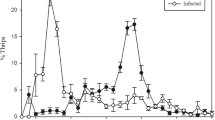Abstract
Insects that become parasitized may behave differently than unparasitized individuals. For instance, some parasitized caterpillars bask at the top of vegetation. Caterpillars of Platyprepia virginalis that had previously been infected by the tachinid parasitoid, Thelaira americana, were more likely to bask on dead vegetation than were unparasitized caterpillars. This behavior was associated with elevated body temperatures compared to individuals that were not basking. This is the first report of behavioral fever by a caterpillar, by any insect in the field, and by any insect caused by a macroparasite rather than a pathogen. The results are consistent with the hypothesis that parasitized caterpillars are induced to develop behavioral fever by basking and this may help them recover from their parasitoids; other interpretations are also possible.
Similar content being viewed by others
REFERENCES
Beckage, N. E. (1997). New insights: How parasites and pathogens alter the endocrine physiology and development of insect hosts. In Beckage, N. E. (ed.), Parasites and Pathogens. Effects on Host Hormones and Behavior, Chapman and Hall, New York, pp. 3–36.
Boorstein, S. M., and Ewald, P. W. (1987). Costs and benefits of behavioral fever in Melanoplus sanguinipes infected by Nosema acridophagus. Physiol. Zool. 60: 586–595.
Carruthers, R. I., Larkin, T. S., Firstencel, H., and Feng, Z. (1992). Influence of thermal ecology on the mycosis of a rangeland grasshopper. Ecology 73: 190–204.
Daniels, F. (1974). Physiological and pathological extracutaneous effects of light on man and mammals, not mediated by pineal or other neuroendocrine mechanisms. in Fitzpatrick, T. B., Pathak, M. A., Harber, L. C., Seiji, M., and Kukita, A. (eds.), Sunlight and Man, University of Tokyo Press, Tokyo, pp. 247–258.
English-Loeb, G. M., Karban, R., and Brody, A. K. (1990). Arctiid larvae survive attack by a tachinid parasitoid and produce viable offspring. Ecol. Entomol. 15: 361–362.
English-Loeb, G. M., Brody, A. K., and Karban, R. (1993). Host-plant-mediated interactions between a generalist folivore and its tachinid parasitoid. J. Anim. Ecol. 62: 465–471.
Hansen, J. D., Ludwig, J. A., Owens, J. C., and Huddleston, E. W. (1984). Motility, feeding, and molting in larvae of the range caterpillar, Hemileuca oliviae (Lepidoptera: Saturniidae). Environ. Entomol. 13: 45–51.
Hart, B. L. (1988). Biological basis of the behavior of sick animals. Neurosci. Biobehav. Rev. 12: 123–137.
Horton, D. R., and Moore, J. (1993). Behavioral effects of parasites and pathogens in insect hosts. In Beckage, N. E., Thompson, S. N., and Federici, B. A. (eds.), Parasites and Pathogens of Insects, Vol. 1, Academic Press, San Diego, pp. 107–124.
Karban, R., and English-Loeb, G. M. (1997). Tachinid parasitoids affect host plant choice by caterpillars to increase caterpillar survival. Ecology 78: 603–611.
Kaya, H. K., and Tanada, Y. (1969). Responses to high temperature of the parasite Apanteles militaris and of its host, the armyworm, Pseudaletia unipuncta. Ann. Entomol. Soc. Am. 62: 1303–1306.
Kluger, M. J. (1991). The adaptive value of fever. In Mackowiak, P. A. (ed.), Fever: Basic Mechanisms and Management, Raven Press, New York, pp. 105–124.
Kluger, M. J., Ringler, D. H., and Anver, M. R. (1975). Fever and survival. Science 188: 166–168.
Louis, C., and Jourdan, J., and Cabanac, J. (1986). Behavioral fever and therapy in a rickettsia-infected Orthoptera. Am. J. Physiol. 250: R991–R995.
McClain, E., Magnuson, P., and Warner, S. J. (1988). Behavioral fever in a Namib Desert tenebrionid beetle Onymacris plana. J. Insect Physiol. 34: 279–284.
Mitchell, D., Laburn, H. P., Matter, M., and McClain, E. (1990). Fever in Namib and other ectotherms. In Seely, M. K. (ed.), Namib Ecology: 25 Years of Namib Research, Transvaal Museum Monograph 7, Transvaal Museum, Pretoria, South Africa, pp. 179–192.
Moore, J. (1995). The behavior of parasitized animals. Bioscience 45: 89–96.
Moore, J. (1998). Parasites and Host Behaviour, Oxford University Press, Oxford.
Rabb, R. L., and Lawson, F. R. (1957). Some factors influencing the predation of Polistes wasps on the tobacco hornworm. J. Econ. Entomol. 50: 778–784.
Stamp, N. E. (1981). Behavior of parasitized aposematic caterpillars: advantageous to the parasitoid or the host? Am. Nat. 118: 715–725.
Watson, D. W., Mullens, B. A., and Petersen, J. J. (1993). Behavioral fever response of Musca domestica (Diptera: Muscidae) to infection by Entomophthora muscae (Zygomycetes: Entomophthorales). J. Invert. Pathol. 61: 10–16.
Williams, G. C., and Neese, R. M. (1991). The dawn of Darwinian medicine. Q. Rev. Biol. 66: 1–22.
Author information
Authors and Affiliations
Rights and permissions
About this article
Cite this article
Karban, R. Caterpillar Basking Behavior and Nonlethal Parasitism by Tachinid Flies. Journal of Insect Behavior 11, 713–723 (1998). https://doi.org/10.1023/A:1022350926720
Issue Date:
DOI: https://doi.org/10.1023/A:1022350926720




